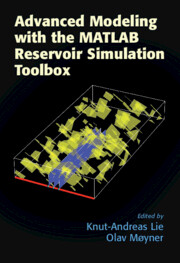Book contents
- Frontmatter
- Contents
- List of Contributors
- Preface
- Acknowledgments
- Navigating the Book and the MRST Modules
- Part I Grid Generation, Discretizations, and Solvers
- Part II Rapid Prototyping and Accelerated Computation
- Part III Modeling of New Physical Processes
- 7 Using State Functions and MRST’ls AD-OO Framework to Implement Simulators for Chemical EOR
- 8 Compositional Simulation with the AD-OO Framework
- 9 Embedded Discrete Fracture Models
- 10 Numerical Modeling of Fractured Unconventional Oil
- 11 A Unified Framework for Flow Simulation in Fractured Reservoirs
- 12 Simulation of Geothermal Systems Using MRST
- 13 A Finite-Volume-Based Module for Unsaturated Poroelasticity
9 - Embedded Discrete Fracture Models
from Part III - Modeling of New Physical Processes
Published online by Cambridge University Press: 20 November 2021
- Frontmatter
- Contents
- List of Contributors
- Preface
- Acknowledgments
- Navigating the Book and the MRST Modules
- Part I Grid Generation, Discretizations, and Solvers
- Part II Rapid Prototyping and Accelerated Computation
- Part III Modeling of New Physical Processes
- 7 Using State Functions and MRST’ls AD-OO Framework to Implement Simulators for Chemical EOR
- 8 Compositional Simulation with the AD-OO Framework
- 9 Embedded Discrete Fracture Models
- 10 Numerical Modeling of Fractured Unconventional Oil
- 11 A Unified Framework for Flow Simulation in Fractured Reservoirs
- 12 Simulation of Geothermal Systems Using MRST
- 13 A Finite-Volume-Based Module for Unsaturated Poroelasticity
Summary
Fractures are often implicitly represented in models used to simulate flow in fractured porous media. This simplification results in smaller models that are computationally tractable. As computational power continues to increase, there has been growing interest in simulation methods that explicitly represent fractures. The embedded discrete fracture model (EDFM) is one such method. In EDFM, fracture and matrix grids are constructed independently. The grids are then coupled to each other via source/sink relations. This modeling approach makes EDFM versatile and easy to use. EDFM has been shown to be able to handle complex fracture networks. The grid construction process is also straightforward and requires minimal fine-tuning. Within academia and industry, EDFM has been used to study geothermal energy production, unconventional gas production, multiphase flow in fractured reservoirs, and enhanced oil recovery processes. In this chapter, the mathematical formulation of EDFM is introduced. We then demonstrate the usage of EDFM via three examples. The first example involves a simple fracture network containing only three fractures. The second involves upscaling a stochastically generated fracture network. Finally, a well test will be simulated in a publicly available data set sourced from the Jandaira carbonate formation in Brazil.
Keywords
- Type
- Chapter
- Information
- Advanced Modeling with the MATLAB Reservoir Simulation Toolbox , pp. 375 - 408Publisher: Cambridge University PressPrint publication year: 2021
- Creative Commons
- This content is Open Access and distributed under the terms of the Creative Commons Attribution licence CC-BY-NC-ND 4.0 https://creativecommons.org/cclicenses/
- 2
- Cited by



